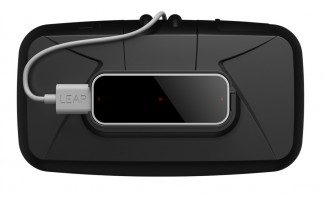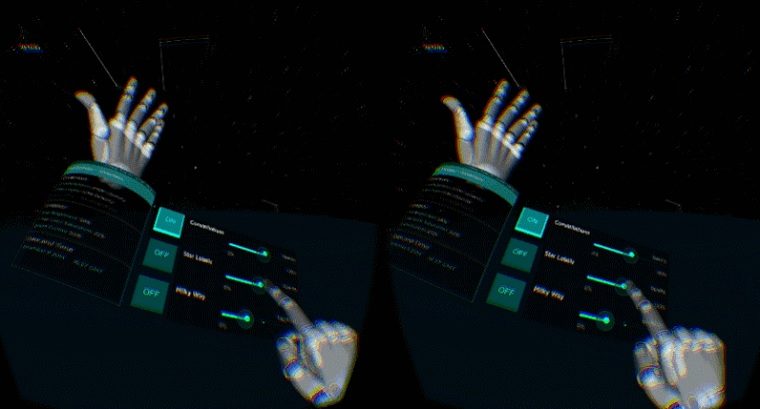
In a new technical demo from Leap Motion’s labs, you can use your hands to soar through space and manipulate entire constellations with mere gestures. The Planetarium aims to illustrate ideas in virtual reality user interfaces and demonstrate the versatility of the company’s motion sensing technology.
Leap Motion, having clearly decided that virtual reality is the platform its IR motion control platform was made for, is going all out with R&D to lead the way in naturalistic user interfaces in VR.
Whilst the stereo IR camera equipped leap motion device, which originally appeared way back in 2010, has always been a device to inspire short-term wonder in those who’ve tried it, there was a sense that it was a technology a little ahead of it’s time. An invention which seemed to be waiting for a companion platform for which it was best suited. Virtual reality, with its as yet unresolved require meant for compelling and naturalistic human input, seems like the perfect choice.

Last year, after big improvements in it’s tracking software Leap launched the beta of it’s ‘V2’ tracking API, with more accurate sensing of finger and arm movements, it answered at least some critic’s calls for a more reliable form of gesture based input. The DK2 developer mount followed and later in 2014, the company held it’s virtual reality specific ‘3D Jam’ contest in order to find out just what developers could do with it all.
But Leap Motion realise that it still needs to lead by example to an extent. During our time with them at CES in January, software demonstrations exploring the capabilities of the device were plentiful, recognising that it’s in software not hardware that the magic really happens. The ‘Widgets Team’ is a group of engineers at Leap tasked with coming up with useful, practical and inspiring ways to use the Leap Motion controller.
See Also: CES 2015: Leap Motion Co-Founders Talk ‘Dragonfly’ Made-for-VR Motion Input Camera

Planetarium is just such an application from that team’s labs and in a recent blog post, project lead Daniel Plemmons details how the app fuses various ‘widgets’, individual user interface controls, to allow the user to manipulate the stars. “I was really curious about seeing how the night sky would look if you could actually sense the difference in distances.” Plemmons explains. “Stars are so far away that the difference in parallax is so small as to be meaningless to the human eye. But if our eyes were a few light-years apart, we’d have a really good sense for the varying distance of stars.” and impressive target for awesome stereoscopy indeed.
The project, which began being coded mostly in Plemmons’ spare time before becoming an official project at Leap, took the engineer into deep detail on how to best represent the stars in our galaxy. “I did some digging and found the HYG star database, a very cleanly formatted CSV database of the brightest stars in the sky (there are billions of stars, we’re rendering just over 100,000).”. Plemmons used the 3D data to map these stars out into Unity 3D space, rendering an accurate picture of the heavens.

So what does this have to do with Leap Motion? “Our ultimate goal for the Planetarium project was twofold – to build a demo for Widgets, which would in turn allow us to incubate and improve them in the context of a production application.” says Plemmons “Controlling the planetarium gave us a well defined set of challenges that could stretch to fit our timeline and resources.”
The demo, available right now for download here, throws in some interesting examples of the team’s widgets with controls operated within individually tracked digits, mapped in 3D space and locked to your own hands’ actions. The application’s a great way to emphasise VR’s ability to convey the enormities of space and its celestial objects, in a similar manner to the much lauded Titans of Space. Planetarium however allows you not only to sense the vastness of space, but manipulate it at will too.
Expect to see much more of Planetarium as the company’s ‘widget’ team continue to refine and fill it with new ideas and UI inventions as time goes on.
You can catch the full blog post over at Leap Motion’s website. If you have even a passing interest in VR or Astronomy it’s a fascinating read. You can download the latest version of Planetarium here.







